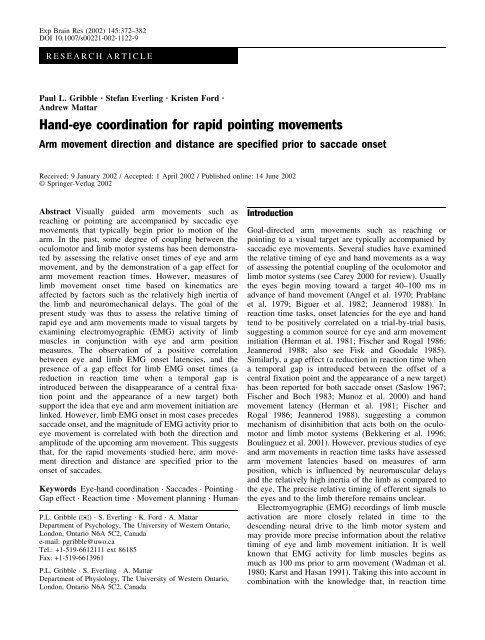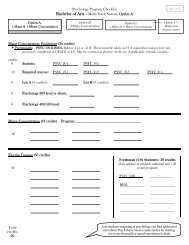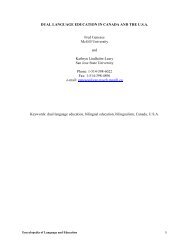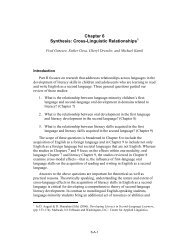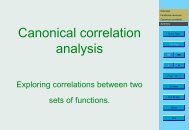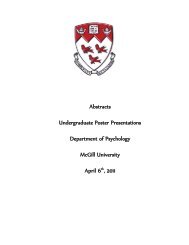Hand-eye coordination for rapid pointing movements - ResearchGate
Hand-eye coordination for rapid pointing movements - ResearchGate
Hand-eye coordination for rapid pointing movements - ResearchGate
You also want an ePaper? Increase the reach of your titles
YUMPU automatically turns print PDFs into web optimized ePapers that Google loves.
Exp Brain Res (2002) 145:372–382<br />
DOI 10.1007/s00221-002-1122-9<br />
RESEARCH ARTICLE<br />
Paul L. Gribble · Stefan Everling · Kristen Ford ·<br />
Andrew Mattar<br />
<strong>Hand</strong>-<strong>eye</strong> <strong>coordination</strong> <strong>for</strong> <strong>rapid</strong> <strong>pointing</strong> <strong>movements</strong><br />
Arm movement direction and distance are specified prior to saccade onset<br />
Received: 9 January 2002 / Accepted: 1 April 2002 / Published online: 14 June 2002<br />
Springer-Verlag 2002<br />
Abstract Visually guided arm <strong>movements</strong> such as<br />
reaching or <strong>pointing</strong> are accompanied by saccadic <strong>eye</strong><br />
<strong>movements</strong> that typically begin prior to motion of the<br />
arm. In the past, some degree of coupling between the<br />
oculomotor and limb motor systems has been demonstrated<br />
by assessing the relative onset times of <strong>eye</strong> and arm<br />
movement, and by the demonstration of a gap effect <strong>for</strong><br />
arm movement reaction times. However, measures of<br />
limb movement onset time based on kinematics are<br />
affected by factors such as the relatively high inertia of<br />
the limb and neuromechanical delays. The goal of the<br />
present study was thus to assess the relative timing of<br />
<strong>rapid</strong> <strong>eye</strong> and arm <strong>movements</strong> made to visual targets by<br />
examining electromyographic (EMG) activity of limb<br />
muscles in conjunction with <strong>eye</strong> and arm position<br />
measures. The observation of a positive correlation<br />
between <strong>eye</strong> and limb EMG onset latencies, and the<br />
presence of a gap effect <strong>for</strong> limb EMG onset times (a<br />
reduction in reaction time when a temporal gap is<br />
introduced between the disappearance of a central fixation<br />
point and the appearance of a new target) both<br />
support the idea that <strong>eye</strong> and arm movement initiation are<br />
linked. However, limb EMG onset in most cases precedes<br />
saccade onset, and the magnitude of EMG activity prior to<br />
<strong>eye</strong> movement is correlated with both the direction and<br />
amplitude of the upcoming arm movement. This suggests<br />
that, <strong>for</strong> the <strong>rapid</strong> <strong>movements</strong> studied here, arm movement<br />
direction and distance are specified prior to the<br />
onset of saccades.<br />
Keywords Eye-hand <strong>coordination</strong> · Saccades · Pointing ·<br />
Gap effect · Reaction time · Movement planning · Human<br />
P.L. Gribble ()) · S. Everling · K. Ford · A. Mattar<br />
Department of Psychology, The University of Western Ontario,<br />
London, Ontario N6A5C2, Canada<br />
e-mail: pgribble@uwo.ca<br />
Tel.: +1-519-6612111 ext 86185<br />
Fax: +1-519-6613961<br />
P.L. Gribble · S. Everling · A. Mattar<br />
Department of Physiology, The University of Western Ontario,<br />
London, Ontario N6A5C2, Canada<br />
Introduction<br />
Goal-directed arm <strong>movements</strong> such as reaching or<br />
<strong>pointing</strong> to a visual target are typically accompanied by<br />
saccadic <strong>eye</strong> <strong>movements</strong>. Several studies have examined<br />
the relative timing of <strong>eye</strong> and hand <strong>movements</strong> as a way<br />
of assessing the potential coupling of the oculomotor and<br />
limb motor systems (see Carey 2000 <strong>for</strong> review). Usually<br />
the <strong>eye</strong>s begin moving toward a target 40–100 ms in<br />
advance of hand movement (Angel et al. 1970; Prablanc<br />
et al. 1979; Biguer et al. 1982; Jeannerod 1988). In<br />
reaction time tasks, onset latencies <strong>for</strong> the <strong>eye</strong> and hand<br />
tend to be positively correlated on a trial-by-trial basis,<br />
suggesting a common source <strong>for</strong> <strong>eye</strong> and arm movement<br />
initiation (Herman et al. 1981; Fischer and Rogal 1986;<br />
Jeannerod 1988; also see Fisk and Goodale 1985).<br />
Similarly, a gap effect (a reduction in reaction time when<br />
a temporal gap is introduced between the offset of a<br />
central fixation point and the appearance of a new target)<br />
has been reported <strong>for</strong> both saccade onset (Saslow 1967;<br />
Fischer and Boch 1983; Munoz et al. 2000) and hand<br />
movement latency (Herman et al. 1981; Fischer and<br />
Rogal 1986; Jeannerod 1988), suggesting a common<br />
mechanism of disinhibition that acts both on the oculomotor<br />
and limb motor systems (Bekkering et al. 1996;<br />
Boulinguez et al. 2001). However, previous studies of <strong>eye</strong><br />
and arm <strong>movements</strong> in reaction time tasks have assessed<br />
arm movement latencies based on measures of arm<br />
position, which is influenced by neuromuscular delays<br />
and the relatively high inertia of the limb as compared to<br />
the <strong>eye</strong>. The precise relative timing of efferent signals to<br />
the <strong>eye</strong>s and to the limb there<strong>for</strong>e remains unclear.<br />
Electromyographic (EMG) recordings of limb muscle<br />
activation are more closely related in time to the<br />
descending neural drive to the limb motor system and<br />
may provide more precise in<strong>for</strong>mation about the relative<br />
timing of <strong>eye</strong> and limb movement initiation. It is well<br />
known that EMG activity <strong>for</strong> limb muscles begins as<br />
much as 100 ms prior to arm movement (Wadman et al.<br />
1980; Karst and Hasan 1991). Taking this into account in<br />
combination with the knowledge that, in reaction time
tasks, saccades can precede movement of the arm by 40–<br />
100 ms, one may hypothesize that arm movement may be<br />
initiated simultaneously with, or perhaps in some cases<br />
prior to saccade onset. The goal of the present study was<br />
thus to test this hypothesis by systematically examining<br />
the relative timing of <strong>eye</strong> and arm movement initiation<br />
using EMG recordings of limb muscles in combination<br />
with recordings of <strong>eye</strong> and limb position.<br />
We show that, in agreement with previous work on<br />
<strong>eye</strong>-hand coupling based on positional measures of limb<br />
movement initiation, a positive correlation is observed<br />
between onset latencies <strong>for</strong> <strong>eye</strong> movement and limb EMG<br />
activity, and a gap effect is observed <strong>for</strong> limb EMG onset.<br />
More interestingly, however, we demonstrate that the<br />
onset of limb EMG activity is not coincident with saccade<br />
initiation – rather, in most cases limb EMG onset occurs<br />
in advance of <strong>eye</strong> movement. In addition, an examination<br />
of the portion of limb EMG activity occurring prior to a<br />
saccade reveals that both the direction and the amplitude<br />
of an upcoming arm movement are specified be<strong>for</strong>e the<br />
onset of <strong>eye</strong> movement. These findings further refine our<br />
knowledge about the relative timing of <strong>eye</strong> and limb<br />
movement initiation and provide novel in<strong>for</strong>mation about<br />
the relative timing of the specification of <strong>eye</strong> and limb<br />
movement parameters by the oculomotor and limb motor<br />
systems in reaction time tasks.<br />
373<br />
Materials and methods<br />
Subjects<br />
Eleven subjects (eight men, three women) between the ages of 21<br />
and 32 years participated in the study. Subjects reported no history<br />
of neurological or musculoskeletal disorders. All subjects provided<br />
written in<strong>for</strong>med consent. The procedures used in this study were<br />
approved by the University of Western Ontario Ethics Review<br />
Board.<br />
Apparatus<br />
Figure 1Ashows the experimental setup. Subjects were seated in<br />
the dark in front of a glass tabletop, with their right arm abducted at<br />
the shoulder and supported by custom made air-sleds (One of a<br />
Kind) in a horizontal plane containing the shoulder. The effect of<br />
the air-sleds, which were connected to a 40-psi compressed air<br />
source, was to support the arm against gravity and to reduce friction<br />
during movement. Medium-density Temper foam (Kees Goebel<br />
Medical) was used to provide a cushion between the arm and the<br />
air-sleds, and as a result the arm was suspended about 10 cm above<br />
the surface of the glass tabletop. Acomputer-controlled LCD<br />
projector was used to project visual targets onto a virtual plane in<br />
front of subjects. Targets were projected onto a back-projection<br />
screen, suspended 20 cm above the hand, and were reflected into<br />
the view of subjects by a semi-silvered mirror positioned 10 cm<br />
below the screen. This resulted in the perception of virtual targets<br />
“floating” in the plane of the subject’s hand. Alamp illuminated the<br />
area below the mirror, providing subjects with full visual feedback<br />
of their arm during the experiment.<br />
Fig. 1A–C Experimental setup and design. A Subjects per<strong>for</strong>med<br />
<strong>rapid</strong> <strong>pointing</strong> <strong>movements</strong> in the horizontal plane, to virtual targets<br />
projected onto the plane of the hand. Acompressed air system<br />
supported the arm against gravity and provided <strong>for</strong> frictionless<br />
motion on a glass tabletop. Subjects pointed to a central fixation<br />
target with the <strong>eye</strong>s and the hand and were instructed to “move the<br />
<strong>eye</strong>s and hand as fast as you can” to a peripheral target, located at<br />
one of three eccentricities to the left- or right-hand side of the<br />
central fixation target. B Peripheral movement targets were located<br />
15, 30, or 45 on either side of the central fixation point. C<br />
Subjects per<strong>for</strong>med 120 <strong>movements</strong> in two experimental conditions.<br />
In the overlap condition, the central fixation target (FP)<br />
remained on throughout the trial. In the gap condition the central<br />
fixation target was extinguished 200 ms prior to the appearance of<br />
the peripheral target stimulus (S). Horizontal hand position (H),<br />
horizontal <strong>eye</strong> position (E), and EMG signals from arm muscles<br />
were recorded<br />
Experimental tasks<br />
Subjects per<strong>for</strong>med <strong>rapid</strong> <strong>pointing</strong> <strong>movements</strong> to visual targets<br />
projected in the horizontal plane. In each trial, subjects were<br />
instructed to look at and hold their hand stationary at a central<br />
fixation target (see Fig. 1A, B). After maintaining this position with<br />
their <strong>eye</strong>s and hand <strong>for</strong> a period of time between 1,750 and 2,250 ms<br />
(randomized across trials), a single peripheral target appeared,<br />
either to the left or right of the central target, and at one of three<br />
different eccentricities: 15, 30, or 45 (see Fig. 1B). These targets<br />
corresponded to hand movement distances of 6 cm, 15 cm, and<br />
30 cm, respectively, to the left and right of the central fixation<br />
target. The order of target presentations was randomized <strong>for</strong> each<br />
subject. Instructions to subjects were to “move your <strong>eye</strong>s and your<br />
hand as fast as you can to the target, and hold the final position”.<br />
No instruction was given about the order or relative timing of <strong>eye</strong>
374<br />
and hand <strong>movements</strong>. After holding the final target position <strong>for</strong><br />
1,500 ms, the target was extinguished and the next trial began.<br />
Subjects were instructed not to make orienting <strong>movements</strong> to the<br />
target with their head, but to hold head position constant throughout<br />
each trial. The central fixation target was 5 mm in diameter (1) and<br />
was surrounded by a circle 30 mm (5) in diameter. The peripheral<br />
targets were 30 mm in diameter. There was an interval of 3,000 ms<br />
between each successive trial.<br />
Subjects per<strong>for</strong>med <strong>movements</strong> in two experimental conditions<br />
(Fig. 1C). In the overlap condition, the central fixation target<br />
remained illuminated throughout the trial. In the gap condition, the<br />
central fixation target was extinguished 200 ms be<strong>for</strong>e the<br />
appearance of the peripheral movement target. In each experimental<br />
condition, subjects completed 120 trials. The order of conditions<br />
was randomized across subjects. A5-min rest period was<br />
introduced between each experimental condition.<br />
Signal recording<br />
An electromagnetic motion-tracking system (Ascension Technology)<br />
was used to record the time-varying position of a receiver with<br />
a spatial resolution of 0.5 mm. The receiver (2.6”2.6”2.08 cm) was<br />
secured to the distal portion of the index finger using adhesive tape.<br />
The position signals were sampled at 140 Hz and stored on a digital<br />
computer <strong>for</strong> off-line analysis. Two additional receivers were<br />
attached to the head, using a Velcro headband, and were used to<br />
measure horizontal rotations of the head during the experimental<br />
task.<br />
EMG activity of limb muscles was recorded using doubledifferential<br />
surface electrodes (Delsys). Each electrode consists of<br />
three 1”10 mm parallel silver bars placed 10 mm apart. Electrodes<br />
were housed in a compact case containing a ”10 preamplifier.<br />
Signals were further amplified ”1,000, analog band-pass filtered<br />
between 20 Hz and 450 Hz, and digitally sampled at 1,000 Hz.<br />
Recordings were made from shoulder muscles that have mechanical<br />
actions resulting in motion of the arm to the left and right, in the<br />
horizontal plane (see Fig. 1A). Recordings were made from the<br />
posterior head of deltoid, a muscle producing shoulder extension<br />
torque (resulting in motion of the arm to the right), and from the<br />
clavicular head of pectoralis, a muscle producing shoulder flexion<br />
torque, resulting in motion of the arm to the left. In light of the<br />
well-documented proximal-to-distal temporal ordering of limb<br />
muscle activation (see Discussion), we chose to focus in this study<br />
on shoulder rather than elbow muscles, to identify the earliest<br />
correlate of limb muscle activity. In two subjects recordings were<br />
also made from the anterior head of deltoid (shoulder flexor),<br />
sternocostal head of pectoralis (shoulder flexor), short head of<br />
biceps (shoulder flexor), and long head of triceps (shoulder<br />
extensor). In all cases the patterns of results <strong>for</strong> triceps long head<br />
were the same as <strong>for</strong> the posterior deltoid, and the results <strong>for</strong> the<br />
anterior deltoid, pectoralis sternocostal head, and biceps short head<br />
were the same as <strong>for</strong> the pectoralis clavicular head (Gribble and<br />
Ostry 1999). Electrode placement was verified prior to data<br />
collection using a combination of isometric <strong>for</strong>ce-production test<br />
maneuvers and shoulder flexion and extension <strong>movements</strong> (Gribble<br />
and Ostry 1998, 1999).<br />
Horizontal <strong>eye</strong> position was recorded using an electro-oculography<br />
(EOG) system (Micromedical Technologies) by placing Ag-<br />
AgCl skin electrodes at the outer canthi of both <strong>eye</strong>s. A ground<br />
electrode was placed just above the <strong>eye</strong>brows in the center of the<br />
<strong>for</strong>ehead. To minimize EOG drift, subjects wore the electrodes <strong>for</strong><br />
approximately 10 min be<strong>for</strong>e the start of the experiments. Because<br />
we were only interested in measuring saccadic reaction times and in<br />
identifying direction errors, we did not attempt to calibrate the EOG<br />
signals <strong>for</strong> absolute <strong>eye</strong> position. EOG signals were digitally<br />
sampled at 1,000 Hz and stored on computer disk <strong>for</strong> off-line<br />
analysis. Signals <strong>for</strong> <strong>eye</strong> position, hand position, and EMG signals<br />
were temporally synchronized using a 100-MHz clock chip<br />
provided on a National Instruments A/D board. Data collection<br />
and target presentation were controlled using custom software<br />
programmed in LabView (National Instruments).<br />
Data analysis<br />
<strong>Hand</strong> position and head orientation signals were digitally low-pass<br />
filtered at 15 Hz using a second-order Butterworth filter implemented<br />
in Matlab (The Mathworks). EMG signals were digitally<br />
band-pass filtered between 30 and 300 Hz, full-wave rectified, and<br />
then low-pass filtered at 50 Hz. Eye position signals were band-stop<br />
filtered at 60 Hz and low-pass filtered at 50 Hz.<br />
For each trial, hand position, <strong>eye</strong> position, head orientation, and<br />
EMG signals were aligned to hand movement onset, which was<br />
scored by identifying 5% of the peak tangential velocity of the hand<br />
during movement. Similarly the onset of saccades was scored on<br />
the basis of 5% of the peak velocity of the <strong>eye</strong> position signal. The<br />
onsets of agonist and antagonist EMG bursts associated with arm<br />
movement were scored using an interactive computer program<br />
written using Matlab. For each muscle, a threshold was determined<br />
based on 3 SDs above the mean EMG signal observed during a 200-<br />
ms window be<strong>for</strong>e the appearance of the peripheral target (or be<strong>for</strong>e<br />
the disappearance of the fixation point in the gap condition). The<br />
onset of an EMG burst was scored as the point in time when the<br />
EMG signal rose above the threshold level. Reaction times were<br />
calculated as the time between the appearance of the peripheral<br />
target and the onset of the saccade, arm movement and each EMG<br />
signal. Data <strong>for</strong> one subject were discarded due to the inability of<br />
the subject to complete the experiment. The analyses reported here<br />
are based on data from the ten remaining subjects. Trials in which<br />
the EMG bursts could not easily be identified, or in which subjects<br />
made a significant movement error (e.g., no motion, or motion in<br />
the incorrect direction), or in which head rotation exceeded 5,<br />
were excluded from these analyses. This resulted in setting aside<br />
between 4 and 32 trials (out of 240 total) per subject (mean 15.6<br />
trials). Analysis of variance (ANOVA) and Tukey post hoc tests<br />
were used to test the statistical reliability of differences between<br />
mean onset times and mean presaccadic EMG activity, and t-tests<br />
were used to test the significance of correlation coefficients (see<br />
Results).<br />
Results<br />
Figure 2 shows typical patterns of <strong>eye</strong> movement, arm<br />
movement and arm muscle activity patterns <strong>for</strong> a single<br />
trial in the gap condition. Arm movement onset is<br />
indicated by a vertical line (H). In this trial the peripheral<br />
target appeared on the left hand side of the central fixation<br />
target. Onset time of the target stimulus is indicated by a<br />
vertical line (S). As was typical <strong>for</strong> all subjects in the<br />
experiment, saccade onset (indicated by a vertical dashed<br />
line over the <strong>eye</strong> position record) occurred about 30–40 ms<br />
prior to the onset of the arm movement. It is clear,<br />
however, from the EMG records that the onset of agonist<br />
muscle activity, in this case recorded from pectoralis,<br />
occurred prior to the onset of <strong>eye</strong> movement – in this trial<br />
about 40 ms be<strong>for</strong>e the onset of the saccade. As is typical<br />
in <strong>rapid</strong> arm movement, the delay between the onset of<br />
agonist EMG activity and arm movement onset was about<br />
80 ms, and antagonist EMG activity (in this case posterior<br />
deltoid) appeared at or just prior to the peak velocity of<br />
the arm movement. The orientation of the head in the<br />
horizontal plane, shown at the bottom of Fig. 2, was<br />
virtually constant across the movement trial.<br />
Limb <strong>movements</strong> were <strong>rapid</strong>, averaging between<br />
210 ms and 340 ms in duration across subjects (mean<br />
291 ms, SD 72 ms). There were no differences in<br />
movement duration in the gap compared with the overlap
375<br />
conditions (P>0.05). Although there were no explicit<br />
instructions regarding accuracy, limb movement errors <strong>for</strong><br />
all subjects were small. Average endpoint error across<br />
subjects ranged from 0.8 cm to 3.3 cm (mean 1.9 cm, SD<br />
0.7 cm). No differences in limb endpoint error were<br />
observed in the gap compared with overlap conditions<br />
(P>0.05). In both the gap and overlap conditions, there<br />
was a small but statistically reliable effect of target<br />
eccentricity on limb endpoint error <strong>for</strong> seven of the ten<br />
subjects (P0.05).<br />
Eye-hand coupling and the gap effect<br />
Fig. 2 Typical data from a single trial are shown <strong>for</strong> one subject.<br />
Records are time-aligned to the onset of hand movement (H). The<br />
appearance of the perhiperal target stimulus is indicated by S.<br />
Horizontal position of the hand, horizontal <strong>eye</strong> position, horizontal<br />
head orientation, posterior deltoid EMG, and pectoralis EMG are<br />
shown over time. Signal changes downward correspond to <strong>movements</strong><br />
to the left and the upward direction corresponds to<br />
<strong>movements</strong> to the right. Vertical dashed lines indicate the onset<br />
of EMG bursts and saccade onset. Note that pectoralis muscle<br />
activity precedes the onset of the saccade, which in turn precedes<br />
the onset of hand movement<br />
To assess the potential coupling between <strong>eye</strong> and hand<br />
<strong>movements</strong>, we compared reaction time latencies <strong>for</strong> <strong>eye</strong><br />
and hand movement onset, as well as <strong>for</strong> EMG onset in<br />
the gap and overlap conditions. Figure 3 shows distributions<br />
of reaction time latencies <strong>for</strong> a typical subject. Data<br />
are shown separately <strong>for</strong> <strong>movements</strong> to the left (dark bars)<br />
and right (light bars) targets. Data are pooled across the<br />
three target eccentricities, and mean reaction time latencies<br />
are indicated in each panel. As was typical <strong>for</strong> all<br />
subjects, a significant decrease in saccadic reaction time<br />
was observed in the gap condition compared with the<br />
overlap condition, <strong>for</strong> both left and right <strong>movements</strong><br />
(P
376<br />
Table 1 ANOVA results <strong>for</strong> main effect of target condition (Gap<br />
vs Overlap), <strong>for</strong> saccade onset (Saccade), arm movement onset<br />
(Arm), and agonist EMG burst onset (EMG). The mean gap effect<br />
(the reaction time reduction in gap as compared to overlap<br />
condition) is shown <strong>for</strong> data pooled across target direction and<br />
eccentricity<br />
Subject Saccade Arm EMG<br />
1 26ms 23ms 24ms<br />
F 1, 221 =30.95 F 1, 221 =30.78 F 1, 221 =35.07<br />
P
Table 2 Correlation coefficients <strong>for</strong> trial-to-trial relationship of<br />
saccade reaction time to arm movement reaction time (Eye-<strong>Hand</strong>)<br />
and agonist EMG burst reaction time (Eye-EMG). Correlations are<br />
shown separately <strong>for</strong> the overlap and gap conditions<br />
Subject Gap Overlap<br />
Eye-<strong>Hand</strong> Eye-EMG Eye-<strong>Hand</strong> Eye-EMG<br />
1 0.59 0.54 0.88 0.87<br />
2 0.22 0.22 0.40 0.30<br />
3 0.52 0.42 0.68 0.68<br />
5 0.55 0.55 0.60 0.62<br />
6 0.68 0.62 0.81 0.81<br />
7 0.43 0.29 0.42 0.41<br />
8 0.54 0.53 0.50 0.53<br />
9 0.27 0.31 0.41 0.36<br />
10 0.25 0.30 0.43 0.50<br />
11 0.53 0.61 0.41 0.57<br />
377<br />
Fig. 5A, B Coordination of reaction times <strong>for</strong> the <strong>eye</strong>s and hand.<br />
Reaction times <strong>for</strong> the onset of hand motion are plotted as a<br />
function of <strong>eye</strong> movement reaction time in the gap (top) and<br />
overlap (bottom) conditions. Data shown are <strong>for</strong> a single typical<br />
subject. Reaction times <strong>for</strong> hand movement lag those <strong>for</strong> <strong>eye</strong><br />
movement onset, but are strongly correlated to saccade onset on a<br />
trial-by-trial basis. Correlation coefficients are shown in each plot<br />
to-trial relationship between saccadic reaction time and<br />
onset times <strong>for</strong> hand movement and EMG activity.<br />
Figure 5 shows hand movement reaction time plotted as<br />
a function of saccadic reaction time in both the gap<br />
(Fig. 5A) and the overlap (Fig. 5B) conditions, <strong>for</strong> a<br />
single typical subject. Data are pooled across target<br />
direction and eccentricity. In both gap and overlap<br />
conditions, a relationship exists between <strong>eye</strong> movement<br />
and hand movement onset times – longer saccadic<br />
reaction times are associated with longer hand reaction<br />
times (gap r=0.59; overlap r=0.88; P
378<br />
Table 3 Number of trials in which the onset of agonist limb EMG<br />
preceded saccade onset, in the gap and overlap conditions. The data<br />
are also given as the proportion of the total number of trials in each<br />
condition (120 trials)<br />
Subject Gap Overlap<br />
1 100 115<br />
83% 96%<br />
2 79 92<br />
66% 77%<br />
3 94 92<br />
78% 77%<br />
5 23 22<br />
19% 18%<br />
6 41 62<br />
34% 52%<br />
7 104 116<br />
87% 97%<br />
8 105 111<br />
88% 93%<br />
9 77 76<br />
64% 63%<br />
10 71 81<br />
59% 68%<br />
11 53 67<br />
44% 56%<br />
Fig. 7A, B Reaction time differences <strong>for</strong> <strong>eye</strong>, hand, and muscle<br />
activity. Mean difference in reaction time <strong>for</strong> hand versus <strong>eye</strong><br />
movement onset (left) and EMG versus <strong>eye</strong> movement onset (right)<br />
are shown <strong>for</strong> ten subjects, in the gap (dark bars) and overlap (light<br />
bars) conditions. Error bars indicate 1 SE of the mean. For all<br />
subjects but one, <strong>eye</strong> <strong>movements</strong> tended to precede the onset of<br />
hand motion by 40–100 ms (mean across subjects, 39.5 ms <strong>for</strong> gap<br />
and 35.1 ms <strong>for</strong> overlap conditions). In contrast muscle activity<br />
tended to precede the onset of <strong>eye</strong> <strong>movements</strong> by 20–80 ms (mean<br />
across subjects, 24.9 ms <strong>for</strong> gap and 29.4 ms <strong>for</strong> overlap)<br />
precede the onset of saccades, even <strong>for</strong> the fastest<br />
responses.<br />
In Fig. 7 we show the mean relative timing delays<br />
between the <strong>eye</strong> and hand, and the <strong>eye</strong> and limb muscle<br />
activity <strong>for</strong> all ten subjects. Figure 7Ashows the mean<br />
difference in time between saccade onset and hand<br />
movement onset, <strong>for</strong> each subject in the gap (dark bars)<br />
and overlap (light bars) conditions. <strong>Hand</strong>-<strong>eye</strong> lag times<br />
across subjects varied between –26 ms (hand preceding<br />
saccade) and +97 ms (saccade preceding hand movement).<br />
For all subjects (except subject 7, and subject 8 in<br />
the overlap condition), the hand movement onset significantly<br />
lagged the saccade onset (P
379<br />
Fig. 9 Arm movement distance is specified prior to saccade onset.<br />
Mean agonist muscle activity prior to saccade onset is shown <strong>for</strong><br />
<strong>movements</strong> in which the onset of EMG activity preceded the onset<br />
of <strong>eye</strong> <strong>movements</strong>. Mean data across ten subjects are shown,<br />
combined <strong>for</strong> <strong>movements</strong> to the left (pectoralis EMG) and right<br />
(posterior deltoid EMG). Mean EMG activity is plotted as a<br />
function of target eccentricity. In both gap (dashed line) and<br />
overlap (solid line) conditions, mean agonist EMG activity prior to<br />
saccade onset is scaled in proportion to target eccentricity and<br />
hence the distance of the upcoming armmovement<br />
Fig. 8A, B Arm movement direction is specified prior to saccade<br />
onset. Mean muscle activity between EMG burst onset and saccade<br />
onset is shown <strong>for</strong> those <strong>movements</strong> in which muscle activity<br />
preceded saccade onset. Data <strong>for</strong> pectoralis and deltoid are shown<br />
separately <strong>for</strong> <strong>movements</strong> to the left (top) and right (bottom) of the<br />
central fixation target, <strong>for</strong> the gap (dark bars) and overlap (light<br />
bars) conditions. Mean data are shown <strong>for</strong> all ten subjects (from left<br />
to right, s1, s2, s3, s5, s6, s7, s8, s9, s10, s11); error bars indicate 1<br />
SE. For <strong>movements</strong> to the left, average muscle activity prior to<br />
saccade onset in pectoralis (a shoulder flexor that produces arm<br />
movement toward the left) was significantly higher than in<br />
posterior deltoid (a shoulder extensor producing limb motion to<br />
the right), which was relatively silent. Similarly <strong>for</strong> <strong>movements</strong> to<br />
the right, mean deltoid muscle activity prior to saccade onset was<br />
significantly higher than in pectoralis, which was relatively silent<br />
time beginning at the agonist EMG onset (pectoralis <strong>for</strong><br />
<strong>movements</strong> to the left, and posterior deltoid <strong>for</strong> <strong>movements</strong><br />
to the right), and ending at the onset of the saccade.<br />
Means were taken after first subtracting the baseline<br />
activity of each muscle, computed over a 100-ms window<br />
be<strong>for</strong>e the appearance of the peripheral target, and then<br />
normalizing the remaining EMG activity to the maximum<br />
value observed in each muscle, over the course of the<br />
entire experiment. These normalizations enabled us to<br />
make comparisons between muscles and across subjects<br />
and were carried out separately <strong>for</strong> each subject. Data<br />
were pooled across the three target eccentricities.<br />
Figure 8 shows the mean presaccadic EMG activity <strong>for</strong><br />
each muscle in both gap (dark bars) and overlap (light<br />
bars) conditions, <strong>for</strong> each of the ten subjects. It can be<br />
seen that, <strong>for</strong> <strong>movements</strong> to the left (Fig. 8A), presaccadic<br />
activity in pectoralis is significantly higher than activity<br />
in posterior deltoid (P0.01 <strong>for</strong> all subjects).<br />
Note that negative values indicate that muscle activity is<br />
reduced relative to the baseline. Similarly, <strong>for</strong> <strong>movements</strong><br />
to the right (Fig. 8B), presaccadic EMG activity in<br />
posterior deltoid is significantly higher than activity in<br />
pectoralis (P0.01 <strong>for</strong> all subjects except subject 7,<br />
who shows a very small but reliable increase relative to<br />
baseline) and, in many cases, lower than baseline (P
380<br />
right) was computed separately <strong>for</strong> each target eccentricity<br />
and pooled over target direction. These data, averaged<br />
across subjects, are shown in Fig. 9. For both gap (dashed<br />
line) and overlap (solid line) conditions, there was a<br />
significant increase in mean presaccadic agonist EMG<br />
activity as a function of the eccentricity of the target – and<br />
hence the distance of the upcoming arm movement<br />
(P
underlying limb motion, often with mono- or biphasic<br />
excitatory bursts of activity (Werner et al. 1997a). This<br />
brainstem neural circuitry <strong>for</strong> trans<strong>for</strong>ming sensory inputs<br />
into motor commands <strong>for</strong> the <strong>eye</strong>, head, and limb may<br />
underlie the <strong>movements</strong> studied in the present paper. A<br />
clear avenue <strong>for</strong> future study is thus to examine the<br />
activity of reach-related SC neurons during combined<br />
<strong>rapid</strong> <strong>eye</strong> and arm <strong>movements</strong>, and in particular to<br />
compare the relative timing of the activity of reachrelated<br />
and saccade-related SC neurons.<br />
Regions of the posterior parietal cortex (PPC), have<br />
also been implicated in the <strong>coordination</strong> of <strong>eye</strong> and limb<br />
<strong>movements</strong>. Recent work by Andersen and colleagues has<br />
suggested that PPC neurons are involved in combining<br />
sensory signals from different modalities and planning<br />
<strong>movements</strong> of the <strong>eye</strong>s and limbs (Andersen et al. 1998;<br />
Snyder et al. 2000). Two areas within PPC have been<br />
identified which are hypothesized to code primarily <strong>eye</strong><br />
<strong>movements</strong> (lateral intraparietal area LIP) and reaching<br />
<strong>movements</strong> (parietal reach region PRR). It has been<br />
proposed that neurons in these areas, through gain<br />
modulations by <strong>eye</strong> and body position signals, code <strong>eye</strong><br />
and arm <strong>movements</strong> in multiple coordinate frames (e.g.,<br />
<strong>eye</strong>, arm, body) simultaneously (Andersen et al. 1998).<br />
Cortical areas more directly related to the production of<br />
limb <strong>movements</strong> such as primary and premotor cortices<br />
have also been proposed as candidates <strong>for</strong> <strong>eye</strong>-hand<br />
<strong>coordination</strong>. Neurons in primate dorsal premotor cortex<br />
and in human primary and premotor cortices modulate<br />
their activity with <strong>eye</strong> and gaze position, suggesting a role<br />
<strong>for</strong> these areas in the integration of <strong>eye</strong>/gaze in<strong>for</strong>mation<br />
and neural commands to the limb (Boussaoud 1995;<br />
Mushiake et al. 1997; Boussaoud et al. 1998; Boussaoud<br />
and Bremmer 1999; Jouffrais and Boussaoud 1999). In<br />
addition, Goldberg and colleagues have reported a<br />
predictive remapping of visual receptive fields in neurons<br />
in posterior parietal cortex (Duhamel et al. 1992), frontal<br />
<strong>eye</strong> field (Umeno and Goldberg 1997), and superior<br />
colliculus (Walker et al. 1995). These early signals related<br />
to upcoming <strong>eye</strong> <strong>movements</strong> could conceivably be used to<br />
initiate voluntary arm <strong>movements</strong>.<br />
While the findings summarized above suggest that <strong>eye</strong><br />
and/or gaze position in<strong>for</strong>mation may in some circumstances<br />
affect the pattern of limb motor commands, it is<br />
conceivable that other mechanisms may underlie the<br />
present results. For example, in the present task, in<strong>for</strong>mation<br />
about the position of a visual target on the retina<br />
may be used to determine the <strong>for</strong>m of neural control<br />
signals to the limb. A<strong>rapid</strong> mechanism <strong>for</strong> programming<br />
limb <strong>movements</strong> to nonfoveated visual targets may be<br />
supported by more direct pathways from visual cortical<br />
areas to premotor and primary motor cortical areas<br />
controlling limb <strong>movements</strong> (see Porter and Lemon<br />
1995; Wise et al. 1997, <strong>for</strong> reviews). For example,<br />
neuroanatomical tracing studies have shown that dorsal<br />
premotor cortex receives direct inputs from the parietooccipital<br />
area, which in turn receives direct inputs from<br />
primary visual cortex (Tanne et al. 1995).<br />
The present findings suggest that, in the <strong>rapid</strong> movement<br />
task studied here, cortical systems subserving arm<br />
<strong>movements</strong> are well in<strong>for</strong>med about target location prior<br />
to saccade onset. This does not mean, however, that<br />
terminal feedback from oculomotor systems is of no use –<br />
this in<strong>for</strong>mation presumably may be used on a trial-totrial<br />
basis to make adjustments to arm motor commands<br />
in response to terminal errors from previous trials. Indeed,<br />
an interesting question is the extent to which the present<br />
findings may be affected by learning or by prior<br />
knowledge of, or experience with the set of possible<br />
target locations. Another direction <strong>for</strong> future study may be<br />
the examination of the precision of the directional coding<br />
of arm <strong>movements</strong> prior to saccades, and its possible<br />
dependence on factors such as practice and the number of<br />
potential targets.<br />
We may also consider the generality of the present<br />
findings, which may depend on task parameters. In the<br />
task studied here, subjects were instructed to move as fast<br />
as possible, with no instruction given about spatial<br />
accuracy. There is evidence that, when an extremely<br />
high degree of spatial accuracy is crucial to the successful<br />
completion of the task, the relative timing of <strong>eye</strong> and arm<br />
<strong>movements</strong> is quite different. For example, in a task in<br />
which subjects were required to grasp and manipulate<br />
small objects with the fingers, <strong>eye</strong> and head <strong>movements</strong><br />
were made toward an upcoming grasp point and preceded<br />
the onset of reaching <strong>movements</strong> to the same locations by<br />
several hundred milliseconds (Johansson et al. 2001). In<br />
the context of this task, the authors propose that gaze<br />
position in<strong>for</strong>ms the limb motor system about the position<br />
of upcoming grasp points and hence the direction in<br />
which to move the arm. For more <strong>rapid</strong> <strong>pointing</strong> tasks,<br />
however, subjects can per<strong>for</strong>m accurate arm <strong>movements</strong><br />
even when the target is not foveated (Craw<strong>for</strong>d et al.<br />
2000). In such a task, <strong>pointing</strong> error tends to vary with the<br />
eccentricity of targets (Henriques and Craw<strong>for</strong>d 2000). It<br />
remains an interesting question whether the relative<br />
timing of saccades and limb EMG activity reported in<br />
the present study might be modulated with the degree of<br />
spatial accuracy required of the subjects during a reaching<br />
or <strong>pointing</strong> task. In addition, in the present study the total<br />
possible number of targets was relatively small (6). It is<br />
possible that, with a larger number of targets or a random<br />
set of target positions, <strong>eye</strong> position and/or gaze in<strong>for</strong>mation<br />
may be required in order to generate appropriate<br />
neural commands to the limb motor system.<br />
Acknowledgements This research was supported by grants from<br />
NSERC (Canada), CIHR (Canada), and the National Alliance <strong>for</strong><br />
Research on Schizophrenia and Depression (USA). The authors<br />
wish to thank M.A. Goodale, D.M. Shiller, D.P. Carey, and an<br />
anonymous reviewer <strong>for</strong> helpful comments.<br />
References<br />
381<br />
Andersen RA, Snyder LH, Batista AP, Buneo CA, Cohen YE<br />
(1998) Posterior parietal areas specialized <strong>for</strong> <strong>eye</strong> <strong>movements</strong>
382<br />
(LIP) and reach (PRR) using a common coordinate frame.<br />
Novartis Found Symp 218:109–122<br />
Angel RW, Alston W, Garland H (1970) Functional relations<br />
between the manual and oculomotor control systems. Exp<br />
Neurol 27:248–257<br />
Bekkering H, Pratt J, Abrams RA (1996) The gap effect <strong>for</strong> <strong>eye</strong> and<br />
hand <strong>movements</strong>. Percept Psychophys 58:628–635<br />
Biguer B, Jeannerod M, Prablanc C (1982) The <strong>coordination</strong> of <strong>eye</strong>,<br />
head, and arm <strong>movements</strong> during reaching at a single visual<br />
target. Exp Brain Res 46:301–304<br />
Boulinguez P, Blouin J, Nougier V (2001) The gap effect <strong>for</strong> <strong>eye</strong><br />
and hand <strong>movements</strong> in double-step <strong>pointing</strong>. Exp Brain Res<br />
138:352–358<br />
Boussaoud D (1995) Primate premotor cortex: modulation of<br />
preparatory neuronal activity by gaze angle. J Neurophysiol<br />
73:886–890<br />
Boussaoud D, Bremmer F (1999) Gaze effects in the cerebral<br />
cortex: reference frames <strong>for</strong> space coding and action. Exp Brain<br />
Res 128:170–180<br />
Boussaoud D, Jouffrais C, Bremmer F (1998) Eye position effects<br />
on the neuronal activity of dorsal premotor cortex in the<br />
macaque monkey. J Neurophysiol 80:1132–1150<br />
Carey DP (2000) Eye-hand <strong>coordination</strong>: <strong>eye</strong> to hand or hand to<br />
<strong>eye</strong>? Curr Biol 10:416–419<br />
Craw<strong>for</strong>d JD, Henriques DY, Vilis T (2000) Curvature of visual<br />
space under vertical <strong>eye</strong> rotation: implications <strong>for</strong> spatial vision<br />
and visuomotor control. J Neurosci 20:2360–2368<br />
Duhamel JR, Colby CL, Goldberg ME (1992) The updating of the<br />
representation of visual space in parietal cortex by intended <strong>eye</strong><br />
<strong>movements</strong>. Science 255:90–2<br />
Fischer B (1989) Visually guided <strong>eye</strong> and hand <strong>movements</strong> in man.<br />
Brain Behav Evol 33:109–112<br />
Fischer B, Boch R (1983) Saccadic <strong>eye</strong> <strong>movements</strong> after extremely<br />
short reaction times in the monkey. Brain Res 260:21–26<br />
Fischer B, Rogal L (1986) Eye-hand-<strong>coordination</strong> in man: a<br />
reaction time study. Biol Cybern 55:253–261<br />
Fischer B, Weber H, Biscaldi M, Aiple F, Otto P, Stuhr V (1993)<br />
Separate populations of visually guided saccades in humans:<br />
reaction times and amplitudes. Exp Brain Res 92:528–541<br />
Fisk JD, Goodale MA(1985) The organization of <strong>eye</strong> and limb<br />
<strong>movements</strong> during unrestricted reaching to targets in contralateral<br />
and ipsilateral visual space. Exp Brain Res 60:159–78<br />
Gribble PL, Ostry DJ (1998) Independent coactivation of shoulder<br />
and elbow muscles. Exp Brain Res 123:355–360<br />
Gribble PL, Ostry DJ (1999) Compensation <strong>for</strong> interaction torques<br />
during single- and multijoint limb movement. J Neurophysiol<br />
82:2310–2326<br />
Henriques DY, Craw<strong>for</strong>d JD (2000) Direction-dependent distortions<br />
of retinocentric space in the visuomotor trans<strong>for</strong>mation <strong>for</strong><br />
<strong>pointing</strong>. Exp Brain Res 132:179–194<br />
Herman R, Herman R, Maulucci R (1981) Visually triggered <strong>eye</strong>arm<br />
<strong>movements</strong> in man. Exp Brain Res 42:392–398<br />
Jeannerod M (1988) The neural and behavioural organization of<br />
goal-directed <strong>movements</strong>. Ox<strong>for</strong>d University Press, Ox<strong>for</strong>d<br />
Johansson RS, Westling G, Backstrom A, Flanagan JR (2001) Eyehand<br />
<strong>coordination</strong> in object manipulation. J Neurosci 21:6917–<br />
6932<br />
Jouffrais C, Boussaoud D (1999) Neuronal activity related to <strong>eye</strong>hand<br />
<strong>coordination</strong> in the primate premotor cortex. Exp Brain<br />
Res 128:205–209<br />
Karst GM, Hasan Z (1991) Timing and magnitude of electromyographic<br />
activity <strong>for</strong> two-joint arm <strong>movements</strong> in different<br />
directions. J Neurophysiol 66:1594–1604<br />
Munoz DP, Dorris MC, Pare M, Everling M (2000) On your mark,<br />
get set: brainstem circuitry underlying saccadic initiation. Can<br />
J Physiol Pharmacol 78:934–944<br />
Murphy JT, Wong YC, Kwan HC (1985) Sequential activation of<br />
neurons in primate motor cortex during unrestrained <strong>for</strong>elimb<br />
movement. J Neurophysiol 53:435–445<br />
Mushiake H, Tanatsugu Y, Tanji J (1997) Neuronal activity in the<br />
ventral part of premotor cortex during target- reach movement<br />
is modulated by direction of gaze. J Neurophysiol 78:567–571<br />
Porter R, Lemon R (1995) Corticospinal function and voluntary<br />
movement. Ox<strong>for</strong>d University Press, Ox<strong>for</strong>d<br />
Prablanc C, Echallier JF, Komilis E, Jeannerod M (1979) Optimal<br />
response of <strong>eye</strong> and hand motor systems in <strong>pointing</strong> at a visual<br />
target. I. Spatiotemporal characteristics of <strong>eye</strong> and hand<br />
<strong>movements</strong> and their relationships when varying the amount<br />
of visual in<strong>for</strong>mation. Biol Cybern 35:113–124<br />
Saslow MG (1967) Effects of components of displacement-step<br />
stimuli upon latency <strong>for</strong> saccadic <strong>eye</strong> movement. J Opt Soc Am<br />
57:1024–1029<br />
Scott SH (1997) Comparison of onset time and magnitude of<br />
activity <strong>for</strong> proximal arm muscles and motor cortical cells<br />
be<strong>for</strong>e reaching <strong>movements</strong>. J Neurophysiol 77:1016–1022<br />
Snyder LH, Batista AP, Andersen RA (2000) Intention-related<br />
activity in the posterior parietal cortex: a review. Vision Res<br />
40:1433–1441<br />
Sparks DL, Hartwich-Young R (1989) The deep layers of the<br />
superior colliculus. Rev Oculomot Res 3:213–255<br />
Tanne J, Boussaoud D, Boyer-Zeller N, Rouiller EM (1995) Direct<br />
visual pathways <strong>for</strong> reaching <strong>movements</strong> in the macaque<br />
monkey. Neuroreport 7:267–272<br />
Umeno MM, Goldberg ME (1997) Spatial processing in the<br />
monkey frontal <strong>eye</strong> field. I. Predictive visual responses.<br />
J Neurophysiol 78:1373–1383<br />
Wadman WJ, Gon JJD van der, Derksen RJ (1980) Muscle<br />
activation patterns <strong>for</strong> fast goal-directed arm <strong>movements</strong>. J Hum<br />
Mov Stud 6:19–37<br />
Walker MF, Fitzgibbon EJ, Goldberg ME (1995) Neurons in the<br />
monkey superior colliculus predict the visual result of impending<br />
saccadic <strong>eye</strong> <strong>movements</strong>. J Neurophysiol 73:1988–2003<br />
Werner W (1993) Neurons in the primate superior colliculus are<br />
active be<strong>for</strong>e and during arm <strong>movements</strong> to visual targets. Eur<br />
J Neurosci 5:335–340<br />
Werner W, Dannenberg S, Hoffmann KP (1997a) Arm-movementrelated<br />
neurons in the primate superior colliculus and underlying<br />
reticular <strong>for</strong>mation: comparison of neuronal activity with<br />
EMGs of muscles of the shoulder, arm and trunk during<br />
reaching. Exp Brain Res 115:191–205<br />
Werner W, Hoffmann KP, Dannenberg S (1997b) Anatomical<br />
distribution of arm-movement-related neurons in the primate<br />
superior colliculus and underlying reticular <strong>for</strong>mation in<br />
comparison with visual and saccadic cells. Exp Brain Res<br />
115:206–216<br />
Wise SP, Boussaoud D, Johnson PB, Caminiti R (1997) Premotor<br />
and parietal cortex: corticocortical connectivity and combinatorial<br />
computations. Annu Rev Neurosci 20:25–42


